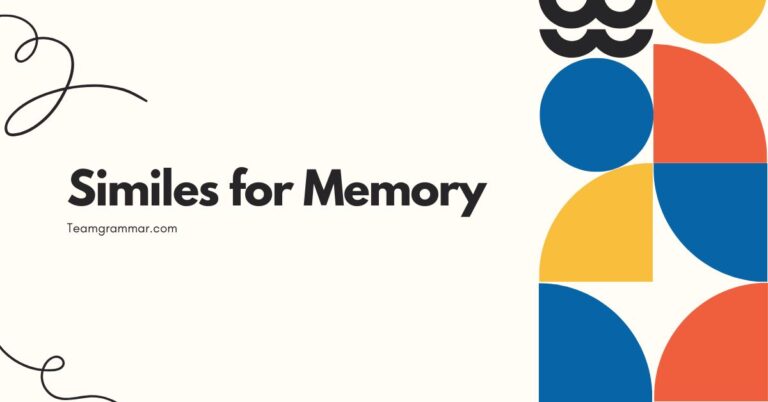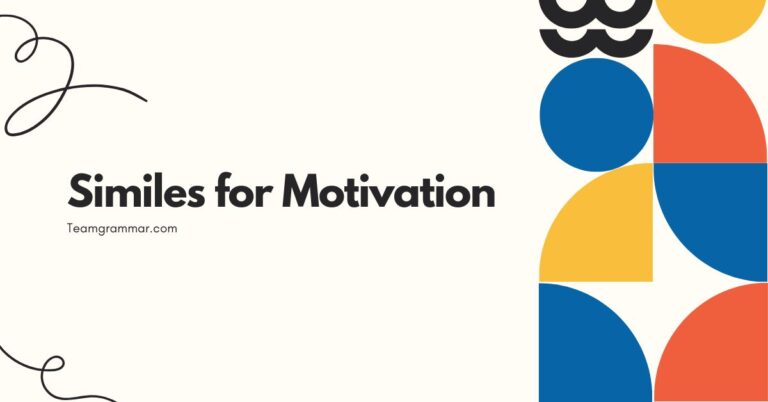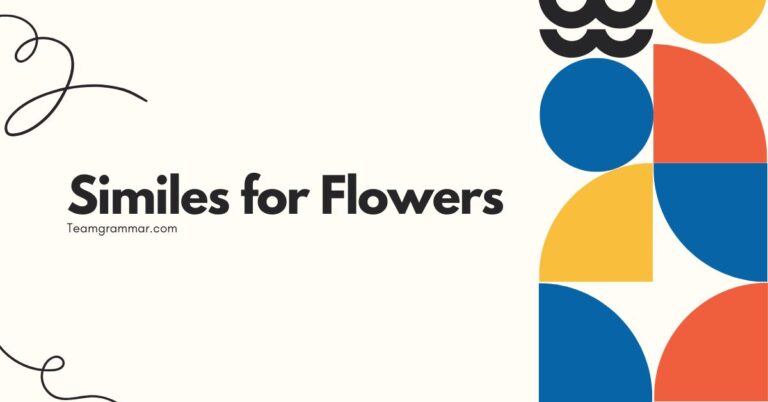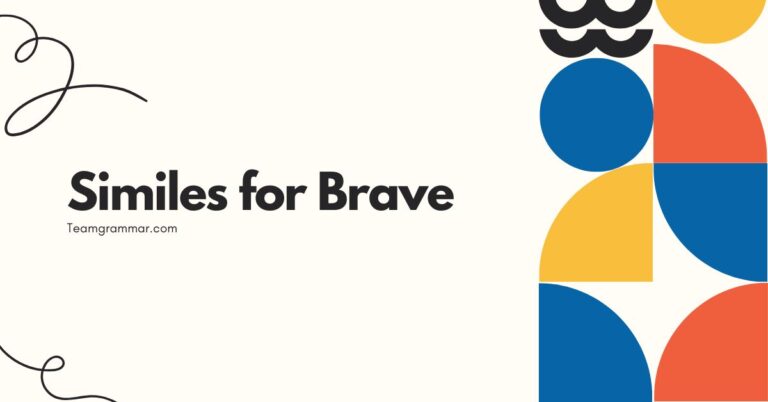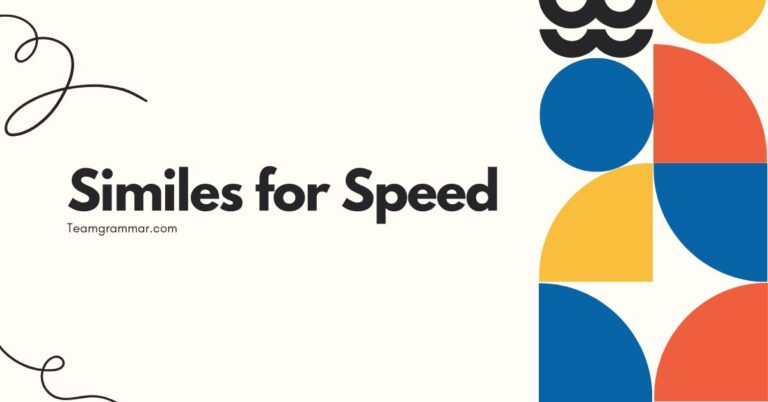33 Similes for Creativity: Sparking Creativity Through Figurative Language
Similes are powerful tools in the English language that can transform ordinary writing into something vibrant and imaginative. Understanding similes is crucial for anyone looking to enhance their creative expression, whether in writing, speech, or even critical thinking.
By comparing seemingly unrelated things, similes allow us to see the world in new ways and communicate ideas with greater clarity and impact. This article provides a comprehensive guide to similes, exploring their definition, structure, types, usage rules, common mistakes, and more.
This resource is beneficial for students, writers, and anyone interested in improving their language skills and creative abilities.
Table of Contents
- Definition of Similes
- Structural Breakdown of Similes
- Types of Similes
- Examples of Similes
- Usage Rules for Similes
- Common Mistakes with Similes
- Practice Exercises
- Advanced Topics in Similes
- Frequently Asked Questions (FAQ)
- Conclusion
Definition of Similes
A simile is a figure of speech that compares two unlike things using the words “like” or “as.” Its primary function is to create a vivid image or a deeper understanding by highlighting the similarities between the two things being compared. Similes add color, emphasis, and clarity to writing and speech.
They are a fundamental part of figurative language, which also includes metaphors, personification, and hyperbole.
Unlike a metaphor, which directly equates two things (e.g., “He is a lion”), a simile acknowledges that the two things are distinct but share a common attribute. This distinction is crucial for understanding the subtle yet powerful effect of similes in communication.
Similes are used extensively in literature, poetry, everyday conversation, and advertising. Their versatility makes them an essential tool for anyone looking to express themselves effectively and creatively.
The context in which a simile is used can significantly influence its meaning and impact. A well-crafted simile can evoke emotions, create humor, or provide a fresh perspective on a familiar subject.
Structural Breakdown of Similes
The basic structure of a simile consists of three main components: the subject, the linking word (“like” or “as”), and the object of comparison. Understanding these components is essential for constructing effective and grammatically correct similes.
The subject is the thing being described or compared. The linking word (“like” or “as”) establishes the comparison between the subject and the object of comparison.
The object of comparison is the thing that the subject is being compared to. The object of comparison should share a characteristic with the subject that is being highlighted.
For example, in the simile “The snow was as white as a sheet,” “the snow” is the subject, “as” is the linking word, and “a sheet” is the object of comparison. The shared characteristic is the color white.
The order of these elements can sometimes be varied for stylistic effect, but the core structure remains the same. For instance, you could say, “As white as a sheet, the snow fell,” but the meaning remains unchanged.
Here is a breakdown of the structural elements:
- Subject: The entity being described.
- Linking Word: “Like” or “As.”
- Object of Comparison: The entity used for comparison.
- Shared Characteristic: The common attribute between the subject and object.
Types of Similes
While all similes use “like” or “as” to make a comparison, they can be further categorized based on their purpose and effect. Some similes are more descriptive, while others are more emphatic or humorous.
Here are a few common types of similes:
Descriptive Similes
Descriptive similes aim to create a vivid image or convey a specific quality of the subject. These similes often appeal to the senses, helping the reader or listener visualize the subject more clearly.
Emphatic Similes
Emphatic similes are used to emphasize a particular aspect of the subject. They often involve strong or exaggerated comparisons to highlight the intensity or significance of the attribute being described.
Humorous Similes
Humorous similes use unexpected or absurd comparisons to create a comedic effect. These similes often rely on irony or hyperbole to generate laughter or amusement.
Cliché Similes
Cliché similes are overused and predictable comparisons that have lost their impact due to overuse. While they are grammatically correct, they are generally avoided in creative writing because they lack originality and freshness.
Examples of Similes
Understanding similes is best achieved through examples. The following tables provide a variety of similes categorized by their function and context.
These examples illustrate the versatility and power of similes in enhancing communication.
Descriptive Similes Examples
The following table illustrates descriptive similes used to create vivid images and enhance understanding of a subject’s qualities.
| Simile | Explanation |
|---|---|
| The lake was as smooth as glass. | Describes the calmness and clarity of the lake. |
| Her voice was like velvet. | Describes the smoothness and richness of her voice. |
| The stars were like diamonds in the sky. | Describes the brightness and sparkle of the stars. |
| The desert was as dry as a bone. | Describes the extreme aridity of the desert. |
| His skin was as cold as ice. | Describes the chilling temperature of his skin. |
| The baby’s skin was as soft as silk. | Describes the delicate and smooth texture of the baby’s skin. |
| The coffee was as black as night. | Describes the deep, dark color of the coffee. |
| The bread was as hard as a rock. | Describes the unyielding texture of the bread. |
| The music was like a soothing balm. | Describes the calming and relaxing effect of the music. |
| The rain fell like tears from the sky. | Describes the gentle and sorrowful descent of the rain. |
| The forest was as dark as a tomb. | Depicts the deep, encompassing darkness of the forest. |
| Her eyes were like sparkling sapphires. | Describes the bright and vibrant color of her eyes. |
| The wind howled like a wolf. | Describes the eerie and mournful sound of the wind. |
| The flowers were as colorful as a rainbow. | Describes the vibrant and varied colors of the flowers. |
| The silence was as thick as fog. | Describes the heavy and all-encompassing nature of the silence. |
| The soup was as hot as lava. | Describes the extreme temperature of the soup. |
| His hair was like spun gold. | Describes the color and texture of his hair. |
| The city was as busy as a beehive. | Describes the bustling and active nature of the city. |
| The snow glistened like a million diamonds. | Describes the sparkling and reflective quality of the snow. |
| The moon was like a silver coin in the sky. | Describes the shape and color of the moon. |
| The grass was as green as emeralds. | Describes the vibrant color of the grass. |
| Her laughter was like a melody. | Describes the pleasant and musical sound of her laughter. |
| The mountains stood like silent giants. | Describes the imposing and majestic presence of the mountains. |
Emphatic Similes Examples
Emphatic similes add intensity and emphasis to descriptions, making them more impactful. The table below provides examples of similes that amplify the qualities being described.
| Simile | Explanation |
|---|---|
| He was as strong as an ox. | Emphasizes his immense physical strength. |
| She was as brave as a lion. | Highlights her exceptional courage. |
| The pain was like a knife twisting in his heart. | Emphasizes the intensity of the emotional pain. |
| He ran as fast as the wind. | Highlights his incredible speed. |
| She was as stubborn as a mule. | Emphasizes her unwavering determination. |
| The argument was as loud as a thunderstorm. | Emphasizes the intensity and disruptive nature of the argument. |
| He was as hungry as a wolf. | Emphasizes his extreme hunger. |
| She worked as hard as a beaver. | Highlights her diligent and tireless work ethic. |
| The car was as old as the hills. | Emphasizes the extreme age of the car. |
| The task was as difficult as climbing Mount Everest. | Emphasizes the extreme difficulty of the task. |
| He was as nervous as a long-tailed cat in a room full of rocking chairs. | Highlights his extreme nervousness in a humorous way. |
| She was as determined as a bulldog. | Emphasizes her strong will and resolve. |
| The traffic moved as slow as molasses in winter. | Emphasizes the extremely slow pace of the traffic. |
| He was as surprised as a deer caught in headlights. | Highlights his state of shock and surprise. |
| She was as graceful as a swan. | Emphasizes her elegant and fluid movements. |
| The heat was as intense as a furnace. | Emphasizes the extreme temperature and intensity of the heat. |
| He was as quiet as a mouse. | Highlights his silence and unobtrusiveness. |
| She was as busy as a one-armed paper hanger. | Emphasizes her state of being extremely busy and overwhelmed. |
| The challenge was as daunting as facing a dragon. | Emphasizes the intimidating and overwhelming nature of the challenge. |
| He was as relentless as a shark. | Highlights his persistence and determination. |
| She was as quick as a whip. | Emphasizes her speed and agility. |
| The city was as alive as a beating heart. | Emphasizes the vibrancy and energy of the city. |
Humorous Similes Examples
Humorous similes add levity and amusement to writing. The table below showcases similes that create a comedic effect through unexpected or absurd comparisons.
| Simile | Explanation |
|---|---|
| He was as useful as a screen door on a submarine. | Highlights his complete lack of usefulness in a specific situation. |
| She was as happy as a clam at high tide. | Describes her extreme happiness in a humorous way. |
| He was as nervous as a cat in a room full of rocking chairs. | Emphasizes his nervousness with a comical image. |
| The explanation was as clear as mud. | Highlights the lack of clarity in the explanation. |
| He was as graceful as a newborn giraffe. | Emphasizes his awkwardness with a humorous comparison. |
| Trying to argue with him is like wrestling a pig in mud: sooner or later you realize the pig is enjoying it. | Highlights the futility and unpleasantness of arguing with him. |
| He’s about as sharp as a marble. | Indicates a lack of intelligence in a humorous way. |
| She sang like a cat being strangled. | Describes her poor singing ability with a funny image. |
| He was as excited as a kid in a candy store. | Emphasizes his excitement with a common and humorous comparison. |
| The meeting dragged on like a bad dream. | Highlights the unpleasant and prolonged nature of the meeting. |
| He was as subtle as a freight train. | Emphasizes his lack of subtlety in a humorous way. |
| She laughed like a hyena. | Describes her loud and somewhat unpleasant laughter. |
| He was as surprised as a fish out of water. | Emphasizes his shock and disorientation. |
| The joke landed like a lead balloon. | Highlights the failure of the joke to elicit laughter. |
| He was as comfortable as a porcupine in a balloon factory. | Emphasizes his discomfort in a humorous and vivid way. |
| She dances like a drunken giraffe. | Describes her clumsy dancing with a funny image. |
| He was as reliable as a chocolate teapot. | Highlights his unreliability in a humorous way. |
| The plan was as sound as a pound. | Indicates that the plan is completely flawed and nonsensical. |
| He was as welcome as a skunk at a lawn party. | Emphasizes his unwelcomeness in a humorous way. |
| She shops like there’s a fire sale every day. | Describes her excessive shopping habits with a funny image. |
Usage Rules for Similes
Using similes effectively requires adhering to certain rules to ensure clarity and impact. Here are some key usage rules to keep in mind:
- Use “like” or “as”: Similes must use either “like” or “as” to establish the comparison.
- Compare unlike things: The subject and object of comparison should be distinct and different.
- Highlight a shared characteristic: The comparison should focus on a specific attribute that the subject and object share.
- Avoid clichés: Opt for fresh and original comparisons to maintain impact and avoid predictability.
- Ensure clarity: The simile should be easy to understand and should enhance, not confuse, the meaning.
It’s also important to consider the context in which the simile is being used. A simile that works well in one situation may not be appropriate in another.
Consider your audience and the overall tone of your writing or speech when choosing similes.
Furthermore, be mindful of cultural differences. Some similes may be culturally specific and may not be understood by people from different backgrounds.
Common Mistakes with Similes
Even experienced writers and speakers can make mistakes when using similes. Here are some common errors to watch out for:
| Mistake | Correct Example | Incorrect Example |
|---|---|---|
| Using “than” instead of “like” or “as” | He is as tall as a tree. | He is taller than a tree. (This is a comparison, not a simile) |
| Comparing similar things | The car was as fast as a rocket. | The car was as fast as another car. (This is a simple comparison) |
| Using clichés | Her smile was like sunshine after a storm. | Her smile was as bright as the sun. (Cliché) |
| Creating confusing comparisons | The idea spread like wildfire through the community. | The idea spread like a complicated equation. (Unclear comparison) |
| Misusing metaphors as similes | He is like a lion in battle. | He is a lion, like. (Incorrect mixing of metaphor and simile) |
By avoiding these common mistakes, you can ensure that your similes are clear, effective, and impactful.
Practice Exercises
Test your understanding of similes with the following exercises. Identify the similes in the sentences below and explain their meaning.
Exercise 1: Identifying Similes
Identify the similes in the following sentences:
| Question | Answer |
|---|---|
| 1. The news hit him like a ton of bricks. | Simile: “like a ton of bricks.” Meaning: The news was overwhelming and shocking. |
| 2. Her laughter was as infectious as a cold. | Simile: “as infectious as a cold.” Meaning: Her laughter spread quickly and easily to others. |
| 3. He moved as stealthily as a shadow. | Simile: “as stealthily as a shadow.” Meaning: He moved quietly and unnoticed. |
| 4. The city at night was like a glittering jewel. | Simile: “like a glittering jewel.” Meaning: The city was beautiful and radiant at night. |
| 5. The old house stood as silent as a grave. | Simile: “as silent as a grave.” Meaning: The house was completely quiet and still. |
| 6. The actor was as dramatic as a Shakespearean character. | Simile: “as dramatic as a Shakespearean character.” Meaning: The actor’s behavior was very theatrical and exaggerated. |
| 7. The children behaved like wild animals. | Simile: “like wild animals.” Meaning: The children were rowdy and unruly. |
| 8. The athlete was as agile as a monkey. | Simile: “as agile as a monkey.” Meaning: The athlete was very nimble and quick. |
| 9. The artist’s brushstrokes were as light as a feather. | Simile: “as light as a feather.” Meaning: The artist’s brushstrokes were delicate and gentle. |
| 10. The detective was as observant as a hawk. | Simile: “as observant as a hawk.” Meaning: The detective was very keen and perceptive. |
Exercise 2: Completing Similes
Complete the following similes with appropriate endings:
| Question | Answer |
|---|---|
| 1. The coffee was as bitter as _____. | The coffee was as bitter as gall. |
| 2. She was as gentle as _____. | She was as gentle as a lamb. |
| 3. He ran as quickly as _____. | He ran as quickly as a cheetah. |
| 4. The room was as cold as _____. | The room was as cold as a freezer. |
| 5. The problem was as simple as _____. | The problem was as simple as ABC. |
| 6. The child slept like _____. | The child slept like a log. |
| 7. The explanation was as confusing as _____. | The explanation was as confusing as a maze. |
| 8. The task was as endless as _____. | The task was as endless as the sea. |
| 9. The old man was as wise as _____. | The old man was as wise as an owl. |
| 10. The garden was as beautiful as _____. | The garden was as beautiful as paradise. |
Exercise 3: Writing Your Own Similes
Write your own similes to describe the following:
- A summer day
- A busy city street
- A sad song
- A delicious meal
- A scary movie
(Answers will vary. Examples might include: A summer day is like a warm embrace.
A busy city street is like a chaotic dance. A sad song is like a gentle rain.
A delicious meal is like a burst of flavor. A scary movie is like a chilling nightmare.)
Advanced Topics in Similes
For advanced learners, exploring the nuances of similes can lead to a deeper understanding of their power and potential. One advanced topic is the use of extended similes, where the comparison is developed over several sentences or even paragraphs.
Another advanced topic is the use of similes in different genres of writing. For example, similes in poetry often have a more lyrical and evocative quality, while similes in scientific writing tend to be more precise and explanatory.
Additionally, exploring the cultural and historical contexts of similes can provide valuable insights into their meaning and significance. Some similes may have different connotations or interpretations depending on the cultural background of the reader or listener.
Finally, advanced learners can experiment with creating original and unconventional similes that challenge traditional comparisons and offer fresh perspectives.
Frequently Asked Questions (FAQ)
- What is the difference between a simile and a metaphor?
A simile compares two unlike things using “like” or “as,” while a metaphor directly equates two unlike things without using “like” or “as.” For example, “He is like a lion” is a simile, while “He is a lion” is a metaphor.
- Can a simile be a cliché?
Yes, a simile can be a cliché if it is overused and predictable. Cliché similes lack originality and impact, such as “as busy as a bee” or “as strong as an ox.” It’s best to avoid clichés and opt for fresh and original comparisons.
- How can I make my similes more creative?
To make your similes more creative, try to think outside the box and find unexpected or unusual comparisons. Consider using sensory details and vivid imagery to enhance the impact of your similes. Also, avoid clichés and strive for originality.
- Is it okay to use similes in formal writing?
Yes, it is generally acceptable to use similes in formal writing, but use them sparingly and thoughtfully. Make sure that the similes are appropriate for the tone and audience of the writing. Avoid using overly casual or humorous similes in formal contexts.
- How do I know if a simile is effective?
An effective simile should be clear, impactful, and relevant to the context. It should enhance the meaning and create a vivid image in the mind of the reader or listener. If the simile is confusing or distracting, it is likely not effective.
- What are some common words used in similes?
The most common words used in similes are “like” and “as.” However, you can also use other words or phrases to introduce a comparison, such as “similar to,” “resembles,” or “in the same way as.”
- Are similes used in everyday conversation?
Yes, similes are commonly used in everyday conversation to add color and emphasis to our speech. We often use similes without even realizing it, such as when we say “He’s as tall as a tree” or “She’s as busy as a bee.”
- Can similes be used in all languages?
Yes, similes are a universal feature of language and can be found in almost all cultures and languages. However, the specific similes used may vary depending on the cultural context and linguistic conventions of each language.
- What role do Similes play in Creative Writing?
Similes are crucial in creative writing because they enhance descriptions, making them more vivid and relatable. They help readers visualize and connect with the text by drawing comparisons to familiar concepts, adding depth and emotion to the narrative. Effective use of similes can transform ordinary writing into something truly memorable.
- How do Similes Enhance Understanding in Technical Writing?
In technical writing, similes simplify complex concepts by relating them to more understandable analogies. They bridge the gap between jargon and common knowledge, making technical information more accessible to a broader audience. By using clear and relevant comparisons, similes improve comprehension and retention of key information.
- Can Similes be used in Public Speaking?
Yes, similes are highly effective in public speaking. They capture the audience’s attention, clarify points, and make speeches more engaging. Similes help listeners quickly grasp complex ideas by linking them to relatable experiences, enhancing the speaker’s ability to communicate effectively and persuasively.
Conclusion
Similes are a valuable tool for enhancing creativity and communication in the English language. By understanding their definition, structure, types, usage rules, and common mistakes, you can use similes effectively to add color, emphasis, and clarity to your writing and speech.
Remember to avoid clichés, strive for originality, and consider the context in which the simile is being used.
Practice using similes regularly to improve your skills and develop your own unique style. With time and effort, you can master the art of simile and unlock its full potential as a powerful tool for creative expression.
Continue to explore advanced topics and experiment with different forms and contexts to deepen your understanding and appreciation of this versatile figure of speech.


